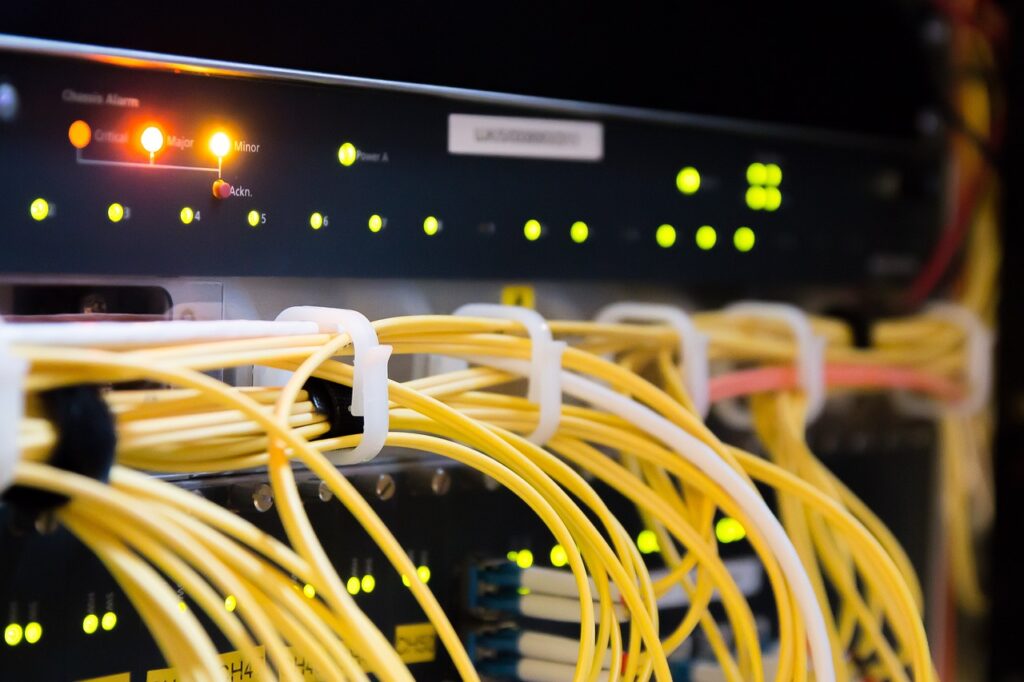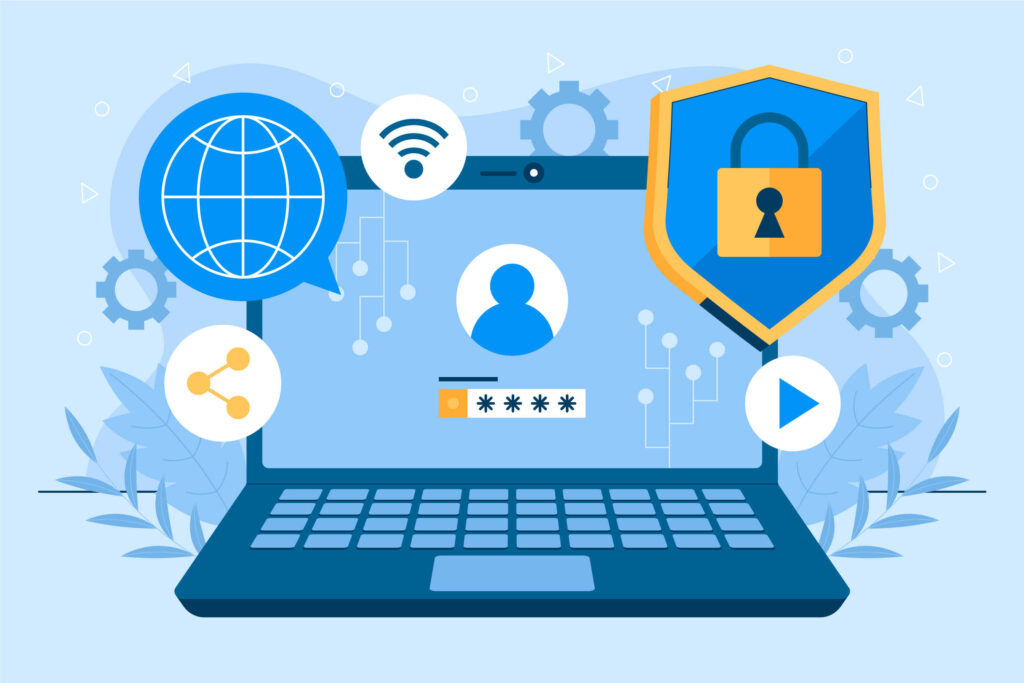What is Network Security
Network security can be defined as the safeguard and protection of networks and systems from cyberthreats. At its core, network security aims to preserve the confidentiality, integrity, and availability of network resources, safeguarding against potential risks that could compromise sensitive data or disrupt business operations.
Network security is essential for protecting data and systems from unauthorised access, misuse, and theft. In today’s digital world, where cyberattacks and data breaches are becoming more common, ensuring network security is more important than ever. Following industry standards and implementing best practices is crucial for maintaining a secure network environment.
By understanding the importance of network security and following industry standards and best practices, organisations can reduce risks, prevent unauthorised access, and protect their valuable data and systems from cyber threats. A comprehensive network security policy is vital in outlining the structured rules and procedures for enforcing, managing, maintaining, and monitoring an organisation’s IT assets and resources, thereby enhancing the overall security posture. In the following sections, we will explore key components of network security, protective measures, industry standards, and the importance of regular network security assessments.
Understanding Network Security
With cyber threats and data breaches on the rise, it is more important than ever to implement robust security measures to secure your environment. By implementing software and hardware technologies, organisations can better safeguard their networks against unauthorised access. To achieve this level of security, organisations can rely on a combination of technologies:
What are the Different Hardware Technologies?
Firewalls
Firewalls act as a barrier between a trusted internal network and an untrusted external network, meticulously regulating incoming and outgoing traffic. This essential function helps control unfriendly traffic, block malware, and prevent application-layer attacks by monitoring and filtering the network traffic based on predetermined security rules, allowing or denying access accordingly.

Routers
Routers are responsible for directing network traffic between different networks. They can also be configured to filter traffic based on predefined rules, providing an additional layer of protection.

Intrusion Prevention Systems (IPS) and Intrusion Detection Systems (IDS)
IPS and IDS are designed to detect and prevent malicious activities within a network. An intrusion prevention system (IPS) is crucial for detecting and preventing various network security attacks, including brute force attacks, Denial of Service (DoS) attacks, and exploits of known vulnerabilities. It actively blocks potential threats, ensuring quick response even when a security patch is not yet applied. Meanwhile, IDS monitors network traffic and alerts administrators when suspicious behaviour is detected.

What Software Technologies are available?
Antivirus Programs
Antivirus software helps protect against diverse types of malware, or malicious software like Trojans, spyware, worms, and adware, by scanning files, email attachments, and websites for known threats. These programs are designed to safeguard computer systems and networks from harm by preventing unauthorised access to sensitive information and financial details.
SIEM (Security Information and Event Management) Software
SIEM software collects and analyses security event logs from various sources, allowing organisations to identify potential security incidents in real-time.
Access Control Mechanisms
Access control ensures that only authorised users have access to specific resources or areas within a network. This includes implementing strong password policies, multi-factor authentication, and user privilege management.
“Access control is particularly important in network security as it limits user privileges and prevents unauthorised entry into a network environment. By implementing access control measures, organisations can significantly reduce the risk of breaches and unauthorised data access.”
In addition to these key components, encryption and Virtual Private Networks (VPNs) are important aspects in hardening network security. Encryption helps protect sensitive data by converting it into a coded form that can only be accessed with the correct decryption key. VPNs create secure connections over public networks, allowing remote users to securely access private network resources that are not otherwise accessible over the internet.
Understanding the importance of hardware and software technologies is crucial for implementing effective network security measures. By implementing these key components, organisations can significantly enhance their security posture. Incorporating network access control is also essential in preventing unauthorised access and attacks on the organisation’s network infrastructure, by limiting user access to internal resources and company assets.
Additional Protective Measures for Network Security
Securing networks against cyber threats relies on a variety of methods to protect against unauthorised access. There are many simple, yet effective methods that can be utilised to further safeguard your network:
Implementing robust network security solutions is crucial for protecting data and resources across the network from potential threats and unauthorised access. These solutions play a pivotal role in maintaining the confidentiality, integrity, and availability of network security policies. Furthermore, network security work involves a comprehensive approach, combining hardware and software tools to enforce security measures and protect network layers against threats. This combination helps in improving network performance without impacting user experience, ensuring that security measures reduce overhead expenses and prevent costly losses from data breaches while safeguarding against disruptions.
Data Loss Prevention (DLP)
DLP solutions help in safeguarding sensitive information from being leaked or stolen by monitoring and blocking the transmission of sensitive data outside the network.

Endpoint Security Solutions
These include antivirus software, full-disk encryption, and endpoint detection and response (EDR) applications to protect individual devices from network-based threats.

Web Security Solutions
URL filtering and web application firewalls (WAFs) defend against online attacks targeting the application layer.

Network Segmentation
Implementing network segmentation isolates critical assets and contains potential breaches within a limited portion of the network, reducing the impact of security incidents.

Cloud Security Solutions
Encryption and appropriately configured access controls are essential for protecting data stored in cloud environments from unauthorised access or exposure.
Whilst deploying these additional protective measures will help to increase the security of your network, it is important to align your efforts with industry standards and best practices to ensure comprehensive security and regulatory compliance.

Industry Standards and Best Practices
Organisations can utilise industry standards and best practices to maximise security and help meet regulatory obligations. Some of the key industry standards and best practices in network security include: Additionally, implementing robust security policies is essential for establishing a common security standard and ensuring the protection of IT assets.
CIS Controls
The Center for Internet Security (CIS) Controls is a widely recognised industry-standard framework that provides a prioritised set of actions to protect against common cyber threats. It consists of 20 critical security controls that organisations can implement to enhance their network security posture.
ISO/IEC 27001
ISO/IEC 27001 is an international standard for information security management systems (ISMS). It provides a systematic approach for organisations to establish, implement, maintain, and continuously improve their information security processes. Adhering to this standard helps organisations identify and manage risks related to network security.
NIST Cybersecurity Framework
Developed by the National Institute of Standards and Technology (NIST), the NIST Cybersecurity Framework provides a flexible framework for managing cybersecurity risks. It consists of five core functions: Identify, Protect, Detect, Respond, and Recover. The framework helps organisations align their network security practices with business objectives.
Best Practices
Regular Software Patching
Keeping software up to date is crucial for network security. Regularly patching operating systems, applications, and firmware helps address known vulnerabilities and reduces the risk of exploitation by attackers.
Employee Awareness Training
Human error is one of the leading causes of network security breaches. Conducting regular employee awareness training programs can help educate employees about potential threats such as phishing attacks, social engineering, and password hygiene.
SIEM Systems
Security Information and Event Management (SIEM) systems collect and analyse log data from various sources across the network. They help organisations detect and respond to security incidents in real-time by providing centralised visibility and correlation of security events.
Vulnerability Scanners
Vulnerability scanners are automated tools that identify vulnerabilities in network devices, applications, and systems. Regularly scanning the network for vulnerabilities enables organisations to proactively address potential weaknesses before they can be exploited.
Strong Access Controls
Implementing access controls ensures that only authorised individuals have access to network resources. This includes using strong passwords, multi-factor authentication, role-based access control (RBAC), and least privilege principles.
It is important to remember network security is an ongoing process that requires continuous monitoring, updating, testing, and improvement. As part of this process, regular network security assessments can help identify and evaluate vulnerabilities active within your network.
Importance of Regular Network Security Assessments
Regular network security assessments are crucial for organisations to ensure the safety of their data and systems from a security breach. These assessments help identify vulnerabilities in a network’s defences that could lead to data loss, sabotage, or unauthorised use, allowing organisations to take proactive measures to address them before they can be exploited by malicious actors. By safeguarding data on the network, network security solutions are designed to keep data secure and allow reliable access to information by various users on the network. Network Security Assessments are important for a number of reasons:
Identifying Vulnerabilities
One of the primary objectives of a network security assessment is to identify any weaknesses or vulnerabilities in the network infrastructure. This can include outdated software, misconfigured devices, weak passwords, or unpatched systems. By uncovering these vulnerabilities, organisations can take immediate steps to fix them and reduce the risk of a potential breach.
Testing Defences
Regular assessments also provide an opportunity to test the effectiveness of existing security measures and protocols. This can involve simulating real-world attacks to see how well the network’s defences hold up. By conducting these tests on a regular basis, organisations can ensure that their security controls are working as intended and make any necessary adjustments.
Compliance Requirements
Many industries have specific regulatory requirements when it comes to data protection and information security. Regular network security assessments can help organisations demonstrate compliance with these standards and avoid potential penalties or legal issues. It shows that they are taking proactive steps to protect sensitive information and maintain the privacy of their customers.
Building Trust
Trust is essential for businesses to thrive. Customers, partners, and stakeholders want to know that their data is being handled securely and that the organisations they interact with are taking security seriously. By conducting regular network security assessments and implementing necessary safeguards, organisations can build trust with their stakeholders and differentiate themselves from competitors.
Overall, regular network security assessments play a crucial role in maintaining a strong cybersecurity posture for organisations. They help identify vulnerabilities, test defences, stay ahead of threats, meet compliance requirements, and build trust with stakeholders. It is important for businesses to prioritise these assessments as part of their overall security strategy.
Maximise your network security with SecQuest
At SecQuest, we understand the complexities and challenges of network security assessments. Our team of experts offers comprehensive assessment services to help your organisation identify vulnerabilities, test defences, and stay ahead of cyber threats. With a tailored approach and industry-leading expertise, we ensure that your network security efforts are robust, effective, and aligned with your business objectives.
If you are looking to safeguard your organisation’s future and fortify its network security posture, contact SecQuest today.



